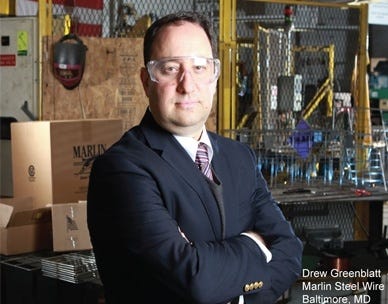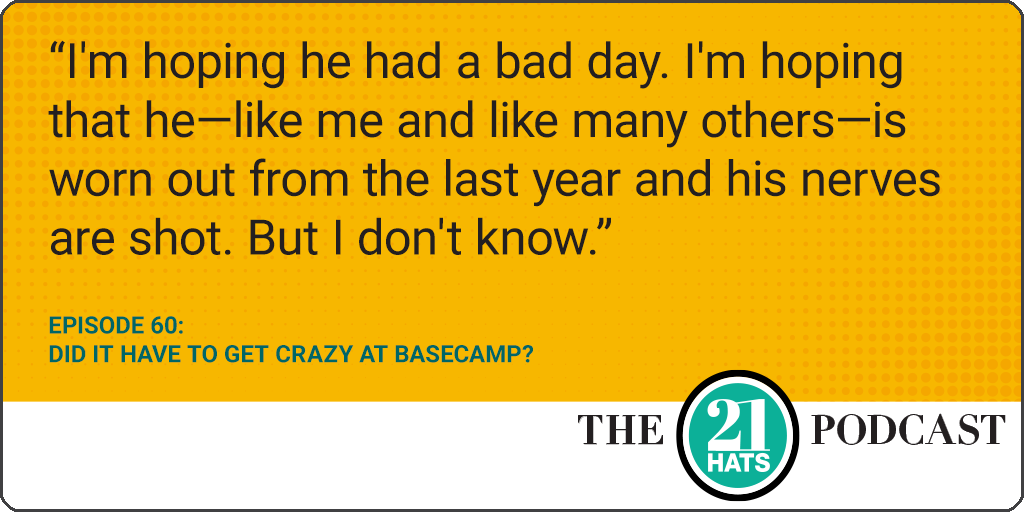Good morning!
Today’s highlights: Restaurants aren’t going back to their old business model. How one manufacturer’s bet on Trump paid off—but not according to plan. And is there a tidal wave of burnout headed our way?
HUMAN RESOURCES
A business owner says there’s a problem with remote work and hybrid models: “I’ve heard from many CEOs that their older, more senior employees — working from comfortable homes and happy to be relieved of commuting — are more reluctant to go back to the office than their younger colleagues, many of whom have been working from small apartments or their parents’ homes. Some research supports that: Commercial real estate firm Cushman & Wakefield reported last year that 70 percent of millennial and Generation X workers ‘struggle more’ with the challenges of working from home, and consulting firm PwC found that fewer than 1 in 5 executives wanted to return to the shared workplace as it was before the pandemic.”
“For business owners, this disparity poses a real problem. As the economy rebounds, we need to hire and attract talent. To do so, we will need leaders on site.”
“People considering just dropping into their office should also think about FOMO, fear of missing out. Those who work from home probably won’t have FOMO, they will just have MO.” READ MORE
Is there a tidal wave of burnout headed our way? “After a year of a remote work environment, it's clear that even the most resilient appearing workforces are suffering from burnout. Front line professions like health care are among the worst hit, with people juggling work, children, aging parents and reporting high stress. People in factories, retail, delivery and public safety have all had to adopt difficult new routines. My company Workhuman recently surveyed 1,000 U.S.-based employees after a year of COVID-19, and the results show that the burnout toll keeps climbing. The price is personal: Employees reported feeling anxious, overwhelmed, and less motivated.”
“The hardest adjustment employees have been asked to make is managing uncertainty, and that's not going to end soon.”
“All this means lower productivity, more sick time, and less engagement.” READ MORE
Job growth numbers fell short in April: “U.S. employers added a modest 266,000 jobs in April and unemployment rose to 6.1 percent, far short of the 1 million expected among economists. The slowdown in hiring signaled a potential slowdown in economic momentum as some businesses struggled to find workers and faced supply-chain issues.”
“The deceleration came after payrolls rose a downwardly revised 770,000 in March and an upward revision of 536,000 in February, the Labor Department said Friday.” READ MORE
MANUFACTURING
Drew Greenblatt bet big on Trump. The bet paid off—but not precisely according to plan. In this interview, Greenblatt talks about the economic turmoil of 2020 and the outlook for small manufacturers: “In early 2020, he expected Marlin to generate nearly $7 million in revenue. Then the Covid-19 pandemic struck, turning the American economy upside down. As the aerospace industry struggled, Marlin saw order after order canceled. With some quick thinking and timely pivots, Greenblatt turned what could have been a disastrous period into the company’s best year ever. In fact, Marlin generated $8 million in revenue, outpacing his original projection.”
“I think the economy was poised to do 4 percent plus. However, when I was making those predictions, I did not anticipate the trade wars, which temporarily depressed domestic GDP.”
“You know, the supply chain is very fragile, as everybody learned with toilet paper. People are realizing how reliant they were on China and how foolish that was.” READ MORE
Chinese manufacturers are sidestepping trade barriers by buying factories overseas: “Over the past decade, China has provided billions of dollars of subsidies to state-owned companies to acquire Western manufacturing rivals and to build factories beyond its own borders. Now, these overseas factories are roiling global markets with low-price goods in sectors ranging from automotive tires and rail equipment to fiberglass and steel. ‘Chinese companies are expanding. They are investing everywhere,’ said Luisa Santos, deputy director of BusinessEurope, the region’s main business association. ‘This means that the flaws we see in the Chinese market are now being exported to other markets.’”
“The U.S. and nations in Europe and elsewhere also subsidize their own industries, often through tax breaks, export financing and research-and-development funding.”
“What makes China different is the outsize role state-controlled companies play in its economy, and its willingness to support their expansion abroad.” READ MORE
FINANCE
Ami Kassar on whether a business that needs $350,000 should wait for the EIBL extension or go for a conventional SBA loan: “As previously discussed, several weeks ago, the SBA announced that the agency was increasing the maximum EIDL loan to $500K from $150K and asked borrowers to email them to get into the queue for the loans. While I know some borrowers who have subsequently been asked for additional information after the first email, I don’t know anybody who has gotten further than the second step.”
“So what should the borrower who needs the money do? My advice was that as in his case, he was likely eligible for a conventional SBA loan, it was probably wise to start that process today.”
“While the terms of traditional SBA loans aren’t as good as the EIDL loans, he might be waiting for a long time and be in a dark hole by just waiting. And if the EIDL comes in, he can always prepay the conventional SBA loan.” READ MORE
PRICING
Restaurants are likely to keep the business-model changes they made, including higher prices: “Expect to see higher wages and more staff benefits reflected in your menu prices. ‘Canlis is more expensive now than it’s ever been, and you’re eating in a yurt outdoors in a parking lot,’ says [Mark] Canlis. His restaurant provided healthcare to all staff who worked through the pandemic, and he sees more restaurants adopting these practices. The same way guests have developed an understanding and appreciation for a restaurant’s sustainability and sourcing practices, ‘you’re going to see the exact same thing from a human capital standpoint,’ he says.”
“Mr. deBary predicts a 20-percent increase in menu prices for restaurants who change their labor practices.”
“‘The message of having a burrito be $25 is to be able to pay your staff an actual livable hourly wage,’ says Ms. Dávila.” READ MORE
Automakers are moving away from selling less expensive cars: “In the old days, American automakers’ business strategy was, as Alfred Sloan’s GM put it, ‘a car for every purse and purpose.’ The idea was that automakers wouldn’t make much on cheap cars for younger buyers but those buyers would stay brand loyal and grow up to buy cars the automakers do make a lot of money on. That hasn’t been automakers’ strategy for a few years now, but it seems the chip shortage has really pushed automakers hard in the opposite direction, which is bad news for those of us interested in cheap cars.”
“That’s right: The chip shortage has provided GM with some insights, one of the big ones being, Why the hell are we bothering selling the things that aren’t very profitable and not more of the other things that are?, the kind of powerful insight that no business can ever unsee.” READ MORE
THE COVID ECONOMY
The chicken shortage just keeps getting worse: “Independent eateries and bars have gone weeks without wings, owners say. Chicken breast prices have more than doubled since the beginning of the year, and wing prices have hit records, according to market-research firm Urner Barry. ‘The overall supply is constrained. That affects every part of the bird,’ Wingstop Chief Executive Charlie Morrison said in an interview earlier this week. Wingstop said it is paying 26 percent more for bone-in chicken wings this year. Mr. Morrison said the company is speaking daily to chicken suppliers that are struggling to raise production because they are having trouble getting enough workers.”
“One reason for the higher prices is the chicken sandwich wars of recent years.”
“For chicken producers, restaurants’ growing poultry appetite is driving a windfall and helping offset surging grain prices.”
“‘Grilling season is just around the corner, when chicken demand is seasonally the strongest historically.’” READ MORE
And here comes yet another shortage: babies: “The Covid-19 pandemic spawned predictions that stay-at-home orders would eventually deliver a baby bump. Yet far from having more children than usual, Americans are expecting fewer. In bedrooms across the U.S., couples are making decisions that, in the aggregate, could prove as consequential for the long-term health of our economy as those taken by policymakers in Washington. Fewer children now means fewer consumers, workers, and taxpayers in the future. In other words, a smaller economy than otherwise—though also a smaller environmental footprint, which brings its own rewards.”
“In June the Brookings Institution released a study predicting the U.S. is headed for ‘a large, lasting baby bust.’”
“Its researchers forecast there will be 300,000 to 500,000 fewer children born in the U.S. in 2021 than there would have been absent the crisis, which amounts to a decrease of roughly 10 percent from 2019.” READ MORE
THE 21 HATS PODCAST
Episode 60: Did It Have to Get Crazy at Basecamp? This week, Jay Goltz, William Vanderbloemen, and Dana White discuss whether Jason Fried, the embattled co-founder and CEO of Basecamp, has displayed courageous leadership or lost his you-know-what.
You can subscribe to The 21 Hats Podcast wherever you get podcasts.
If you see a story that business owners should know about, hit reply and send me the link. If you got something out of this email, you can click the heart symbol, you can click the comment icon below, and you can share it with a friend. Thanks for reading, everyone. — Loren




